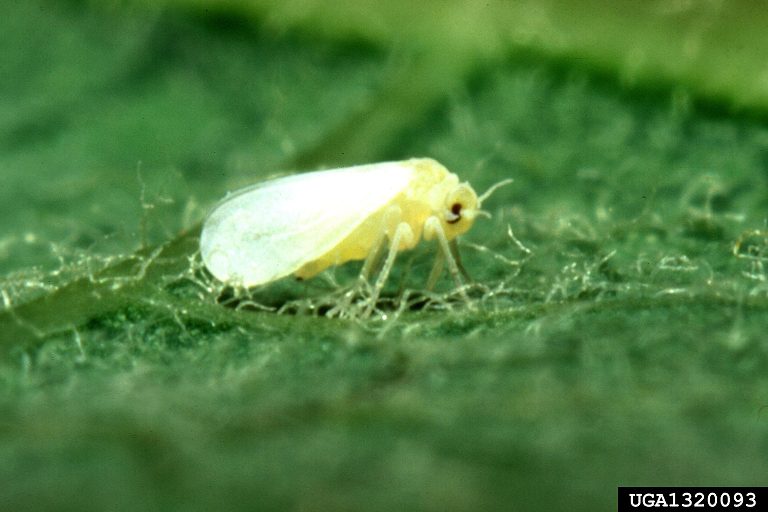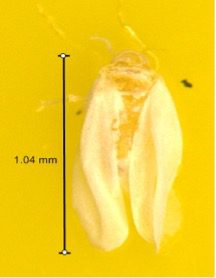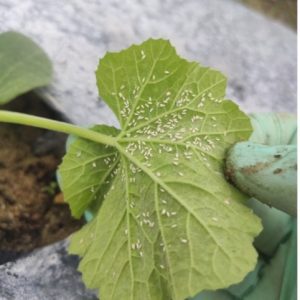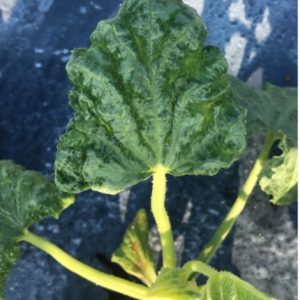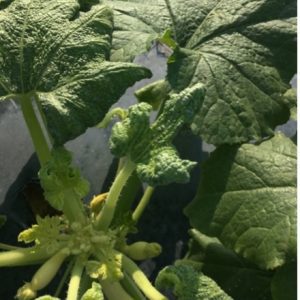Oct 20, 2021Watch for high silverleaf whitefly activity in Southeast
Large populations of silverleaf whiteflies (Bemisia tabaci) have become more common during the fall in the southeastern United States, including Alabama. This increase has resulted in a reduction in the yield of vegetable crops affected by this insect. These include yellow squash, zucchini, tomato, cucumber and snap beans.
Yield reductions are caused by the insect feeding on the leaves, but mostly by whitefly-transmitted viruses. Between 2016 and 2017 whitefly-transmitted viruses led to losses of more than $50 million in Georgia (Little, 2019). In Alabama, whitefly and whitefly-transmitted viruses hit the southeast portion of the state the hardest, but the insect has also been reported in central Alabama.
- Adult whitefly
- Whiteflies on the lower leaf surface of yellow squash.
Whitefly populations tend to increase in dry and sunny conditions, while whiteflies are reduced during cloudy or rainy weather. In 2021, frequent rainfall events in Alabama have reduced the whitefly population in Alabama. The figure below shows the weekly number of whiteflies captured in traps installed in vegetable fields in southeastern and central Alabama. However, the dry conditions in the fall season may increase the whitefly infestations, so growers are recommended to follow IPM guidelines to minimize the crop damage on susceptible crops.
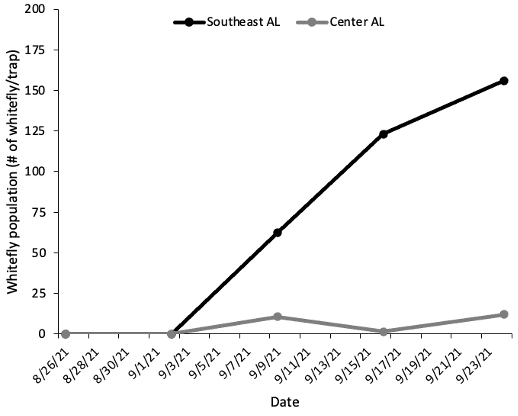

Whitefly population in southeast and central Alabama during the fall vegetable season, 2021.
Identification
Adult silverleaf whitefly is a small insect covered with a white and waxy layer. It feeds in the abaxial (underside) part of leaves. Whiteflies use piercing-sucking mouthparts to feed on the phloem tissue, which is the plant tissue responsible for nutrients transportation. During feeding, the exchange of fluids causes the transmission of plant viruses. In vegetables, common whitefly-transmitted viruses are Cucurbit leaf crumple virus, Cucurbit yellow stunting disorder virus, Squash vein yellowing virus, Tomato yellow leaf curl virus, and Tomato chlorosis virus. When the viruses are introduced in the growing systems, their transmission is quick and causes great threat to economical production.
- Symptoms of Cucurbit leaf crumple virus in zucchini plants.
- Symptoms of Cucurbit leaf crumple virus in zucchini plants.
General whitefly control
Organic systems
Use of temporary pest exclusion fabric like Protecknet and Super Lite Insect Barrier can reduce the early onset of whiteflies, but watch out for prolonged usage of these materials to avoid fruit setting and disease issues. Insecticidal soap, neem, and horticultural oil applications at frequent intervals can suppress early infestation, but may not work in high insect populations that could lead to outbreaks. The use of biological control agents (predators and parasitoids) is highly recommended in closed environments but could be difficult to implement in open field conditions. Avoid using natural pyrethrin based materials to conserve natural enemies in crops.
Conventional systems
Several systemic insecticides belonging to Mode of Action (MOA) 4A (acetamiprid, imidacloprid), 4D (flupyradifurone), and 28 (chlorantraniliprole) are available for early season chemigation, soil, or foliar applications with labeled restrictions. Pyriproxifen (MOA 7C) is an insect growth regulator, and pyrifluquinazon (MOA 9B) is a feeding blocker with unique mode of action that can be incorporated in cases of resistant populations on large acres.
IPM guides
Refer to the 2021 Southeastern Vegetable Production Handbook, Home Garden Vegetable Insecticide Guide, the Organic Vegetable IPM Slide Chart, or the Urban Farm IPM Slide Chart for insecticide choices related to specialty crops.
Use the Farming Basics App on any mobile device to find other insect pests of specialty crops and to connect to regional Extension agents in your area.
– Andre da Silva, Ayanava Majumdar, and Edward Sikora, Alabama Cooperative Extension System


